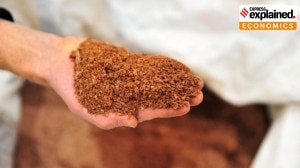Agitated and anxious in the land of the Upanishads
A survey by Hong Kong-based Political and Economic Risk Consultancy shows that stress levels are higher in developing and fast-growing Asian...

A survey by Hong Kong-based Political and Economic Risk Consultancy shows that stress levels are higher in developing and fast-growing Asian economies like India. The survey, which scored countries for their stress levels on a scale from 1 to 10, shows higher stress in China (6,7), Indonesia (6.6) and India (6.1) as compared to USA (5.2), Britain (4.5) and Australia (3.5). Lower stress levels in developed economies are attributed to greater stability in business and a mature social and urban infrastructure.
To most of us, stress is synonymous with worry. However, to our body, any change in life — ‘good’ or ‘bad’ — causes stress. So while working in a high pressure job or getting fired generates stress, so does getting married or shifting into your dream apartment. Even imagined change — or worrying — is stress.
The Social Readjustment Rating Scale of Thomas Holmes and Richard Rahe measures stress produced by various events in life. Thus, while death of spouse produces extreme stress rated at 100, vacations and even a minor violation of law present a stress level of 5-101. Divorce, menopause and puberty have a stress rating of 60-65; marriage, pregnancy, getting fired and retirement are lower at 35-45. Moreover, a major change in life is like dropping a rock into a pond: after the initial splash, ripples of stress may continue for even a year.
So, what happens in stress?
Stress critically affects all our systems — the first organ to change being the brain. Normally, vital chemicals carry messages between brain cells. ‘‘Happy messengers’’ (serotonin, noradrenalin, and dopamine) carry happy, upbeat messages. Sombre messages are carried by ‘‘sad messengers’’. Usually, our nerve centers receive a balanced input from both types of messengers and life runs evenly. However, during stress, happy messages begin to fail.
Serotonin — the first happy messenger to fail during stress – sets our body clock and ensures that we sleep easily and soundly, and wake up refreshed. The first sign of overstress is thus inability to get restful sleep. When stress reduces noradrenalin, one feels increasingly tired. Lowered levels of dopamine reduce pleasure in life.
When overstressed, one feels overwhelmed by life, one cries easily, and feels depressed. At times, the heart races in panic, chest muscles ache and pain, and dizziness occurs along with stomach upsets. Chronic stress also causes headaches, trembling, shaking, itchy skin rashes and sexual difficulties. Most of the times, we are not even aware that we are ‘‘stressed’’. Our daily routine includes a number of substances that make us feel better — albeit temporarily. These substances — technically termed Pick-Me-Ups — boost levels of happy messengers, which temporarily restore balance to the overstressed brain.
Sugar is the most popular Pick-Me-Up. Caffeine — the second most widely used one — is a brain-active drug found not only in coffee, but also in chocolate, in sodas, and many teas. Alcohol helps us sleep and increases sense of well-being. Cigarettes, chewing tobacco and snuff contain nicotine, a potent Pick-Me Up. Often, these Pick-Me-Ups are combined: a chocolate bar contains both sugar and caffeine; Bailey’s Irish cream combines sugar, caffeine and alcohol. Some people even inhale solvents — glues, cleaning fluids, nail polish remover, gasoline fumes, etc. Solvent vapors act on the brain just like alcohol. In extreme cases, people resort to drugs such as marijuana, cocaine, amphetamines, and heroin — all Pick-Me Ups.
Interestingly, many people use their own adrenalin release as a Pick-Me-Up. The workaholic works 16-20 hours a day keeping ‘‘high’’ on his or her body’s own adrenalin release. Compulsive shoppers and people who indulge in thrill-seeking hobbies like gambling, sports, etc. are also rousing their own adrenalin for a temporary high!
When the brain is starved of happy messengers, the effect of a Pick-Me-Ups is enormous. Thus, a normal person taking an alcoholic beverage may find it mildly pleasureful; a stressed person may take one drink, develop a binging bout and drink himself to unconscious. Have you ever noticed that eating one small piece of chocolate is never enough?
Only our body can accurately balance brain chemistry. All Pick-Me-Ups have a ‘‘rebound’’ effect. When you eat a bar of chocolate, you are giving yourself a big slug of sugar and caffeine. The sugar high quickly boosts happy messenger levels; however, the subsequent sugar low — causing lack of energy, fatigue, aches and illness — is equally fast. Most Pick-Me-Up users are on a constant up and-down roller coaster of feeling well and feeling ill.
A Pick-Me-Ups user has to take ever-increasing amounts of the Pick-Me-Up to achieve the desired effect. Remember how you began by drinking just one cup of tea/ coffee at work, and ended up drinking a potful? Same is the case with cigarettes, alcohol and drugs!
Using large amounts of Pick-Me-Ups has serious side effects. Excessive caffeine can cause abnormal heart rhythms. Heavy tobacco use damages lungs and arteries and causes cancer. Excessive drinking runs a risk of accidents, liver failure, or bleeding complications. Heavy doses of illegal drugs can cause convulsions, overdose, or death.
Continued use of Pick-Me-Ups — even seemingly innocent ones like tea and coffee — makes the roller coaster ride steeper, faster and wilder day by day. So remove all Pick-Me-Ups from the house, Instead, eat a well-balanced diet with plenty of fruits and vegetables, as well as foods high in complex carbohydrates. Adopt any physical exercise for 30 minutes five times a week. Vigorous walking is considered the best way to reduce stress. Try out deep breathing exercises and a massage from time to time. Become a ‘kid’ again: draw; paint; be creative and express yourself freely.
The writer is a nutrition and health researcher





- 01
- 02
- 03
- 04
- 05


























